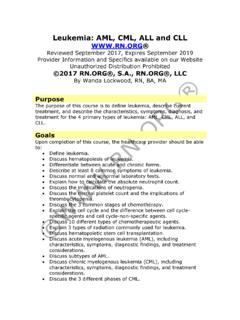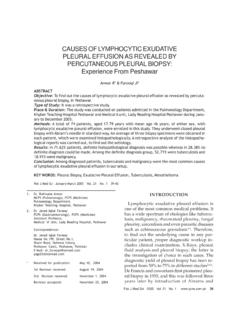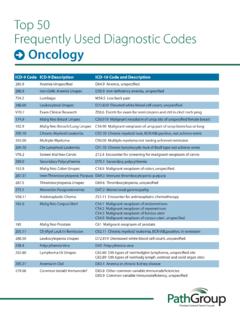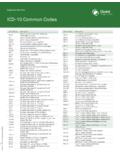Transcription of Section VIII-E: Viral Agents
1 200 Biosafety in Microbiological and Biomedical LaboratoriesSection viii -E: Viral AgentsHantavirusesHantaviruses are negative sense RNA viruses belonging to the genus Hantavirus within the family Bunyaviridae. The natural hosts of hantaviruses are rodent species and they occur worldwide. Hantavirus pulmonary syndrome (HPS) is a severe disease caused by hantaviruses such as Sin Nombre virus or Andes virus whose hosts are rodents in the subfamily Sigmodontinae. This subfamily only occurs in the New World, so HPS is not seen outside North and South America. Hantaviruses in Europe and Asia frequently cause kidney disease, called nephropathica epidemica in Europe, and hemorrhagic fever with renal syndrome (HFRS) in InfectionsDocumented laboratory-acquired infections have occurred in individuals working with Extreme caution must be used in performing any laboratory operation that may create aerosols (centrifugation, vortex-mixing, etc.)
2 Operations involving rats, voles, and other laboratory rodents, should be conducted with special caution because of the extreme hazard of aerosol infection, especially from infected rodent Modes of InfectionHPS is a severe, often fatal disease that is caused by Sin Nombre and Andes or related ,6 Most cases of human illness have resulted from exposures to naturally infected wild rodents or to their excreta. Person-to-person transmission does not occur, with the exception of a few rare instances documented for Andes Arthropod vectors are not known to transmit Safety and Containment RecommendationsLaboratory transmission of hantaviruses from rodents to humans via the aerosol route is well Exposures to rodent excreta, especially aerosolized infectious urine, fresh necropsy material, and animal bedding are presumed to be associated with risk.
3 Other potential routes of laboratory infection include ingestion, contact of infectious materials with mucous membranes or broken skin and, in particular, animal bites. Viral RNA has been detected in necropsy specimens and in patient blood and plasma obtained early in the course of HPS;8,9 however, the infectivity of blood or tissues is practices, containment equipment, and facilities are recommended for laboratory handling of sera from persons potentially infected with hantaviruses. The use of a certified BSC is recommended for all handling of human body fluids when potential exists for splatter or aerosol. agent Summary Statements: Viral Agents 201 Potentially infected tissue samples should be handled in BSL-2 facilities following BSL-3 practices and procedures.
4 Cell-culture virus propagation and purification should be carried out in a BSL-3 facility using BSL-3 practices, containment equipment and infected rodent species known not to excrete the virus can be housed in ABSL-2 facilities using ABSL-2 practices and procedures. Primary physical containment devices including BSCs should be used whenever procedures with potential for generating aerosols are conducted. Serum or tissue samples from potentially infected rodents should be handled at BSL-2 using BSL-3 practices, containment equipment and procedures. All work involving inoculation of virus-containing samples into rodent species permissive for chronic infection should be conducted at IssuesTransfer of agent Importation of this agent may require CDC and/or USDA importation permits.
5 Domestic transport of this agent may require a permit from USDA/ Virus (formerly known as Equine Morbillivirus) and Nipah VirusHendra virus and Nipah virus are members of a newly recognized genus called Henipavirus, within the family Paramyxoviridae. Outbreaks of a previously unrecognized paramyxovirus, at first called equine morbillivirus, later named Hendra virus, occurred in horses in Australia in 1994 and 1995. During 1998-1999, an outbreak of illness caused by a similar but distinct virus, now known as Nipah virus, occurred in Malaysia and Singapore. Human illness, characterized by fever, severe headache, myalgia and signs of encephalitis occurred in individuals in close contact with pigs ( , pig farmers and abattoir workers).10-14 A few patients developed a respiratory disease.
6 Approximately 40% of patients with encephalitis died. Recently, cases of Nipah virus infection were described in Bangladesh, apparently the result of close contact with infected fruit bats without an intermediate ( , pig) InfectionsNo laboratory-acquired infections are known to have occurred because of Hendra or Nipah virus exposure; however, three people in close contact with ill horses developed encephalitis or respiratory disease and two Modes of InfectionThe natural reservoir hosts for the Hendra and Nipah viruses appear to be fruit bats of the genus Studies suggest that a locally occurring member 202 Biosafety in Microbiological and Biomedical Laboratoriesof the genus, Pteropus giganteus, is the reservoir for the virus in Individuals who had regular contact with bats had no evidence of infection (antibody) in one study in Safety and Containment RecommendationsThe exact mode of transmission of these viruses has not been established.
7 Most clinical cases to date have been associated with close contact with horses, their blood or body fluids (Australia) or pigs (Malaysia/Singapore) but presumed direct transmission from Pteropus bats has been recorded in Bangladesh. Hendra and Nipah viruses have been isolated from tissues of infected animals. In the outbreaks in Malaysia and Singapore, Viral antigen was found in central nervous system, kidney and lung tissues of fatal human cases26 and virus was present in secretions of patients, albeit at low Active surveillance for infection of healthcare workers in Malaysia has not detected evidence of occupationally acquired infections in this of the unknown risks to laboratory workers and the potential impact on indigenous livestock should the virus escape a diagnostic or research laboratory, health officials and laboratory managers should evaluate the need to work with the virus and the containment capability of the facility before undertaking any work with Hendra, Nipah or suspected related viruses.
8 BSL-4 is required for all work with these viruses. Once a diagnosis of Nipah or Hendra virus is suspected, all diagnostic specimens also must be handled at BSL-4. ABSL-4 is required for any work with infected IssuesSelect agent Hendra and Nipah virus are select Agents requiring registration with CDC and/or USDA for possession, use, storage and/or transfer. See Appendix F for additional of agent Importation of this agent may require CDC and/or USDA importation permits. Domestic transport of this agent may require a permit from USDA/APHIS/VS. A DoC permit may be required for the export of this agent to another country. See Appendix C for additional A Virus, Hepatitis E VirusHepatitis A virus is a positive single-stranded RNA virus, the type species of the Hepatovirus genus in the family Picornaviridae.
9 Hepatitis E virus is a positive single-stranded RNA virus, the type species of the genus Hepevirus, a floating genus not assigned to any family. agent Summary Statements: Viral Agents 203 Occupational InfectionsLaboratory-associated infections with hepatitis A or E viruses do not appear to be an important occupational risk among laboratory personnel. However, hepatitis A is a documented hazard in animal handlers and others working with naturally or experimentally infected chimpanzees and other nonhuman Workers handling other recently captured, susceptible primates (owl monkeys, marmosets) also may be at risk for hepatitis A infection. Hepatitis E virus appears to be less of a risk to personnel than hepatitis A virus, except during pregnancy, when infection can result in severe or fatal Modes of InfectionMost infections with hepatitis A are foodborne and occasionally water-borne.
10 The virus is present in feces during the prodromal phase of the disease and usually disappears once jaundice occurs. Hepatitis E virus causes acute enterically-transmitted cases of hepatitis, mostly waterborne. In Asia, epidemics involving thousands of cases have Safety and Containment RecommendationsThe Agents may be present in feces and blood of infected humans and nonhuman primates. Feces, stool suspensions, and other contaminated materials are the primary hazards to laboratory personnel. Care should be taken to avoid puncture wounds when handling contaminated blood from humans or nonhuman primates. There is no evidence that aerosol exposure results in practices, containment equipment, and facilities are recommended for the manipulation of hepatitis A and E virus, infected feces, blood or other tissues.















